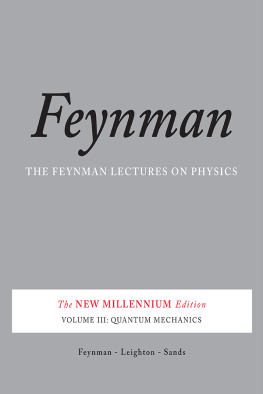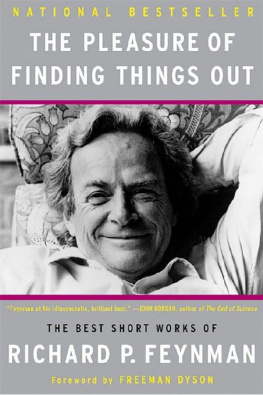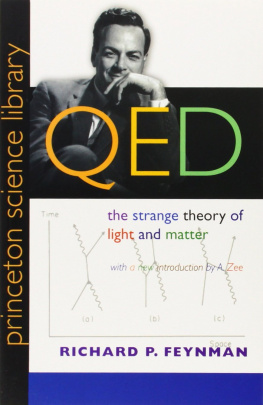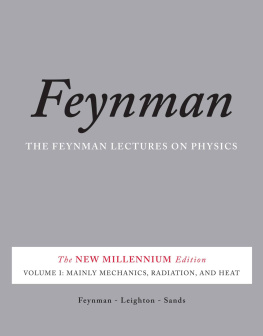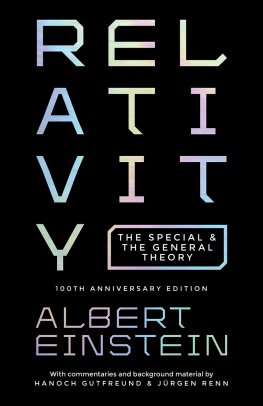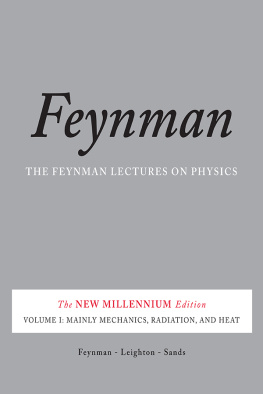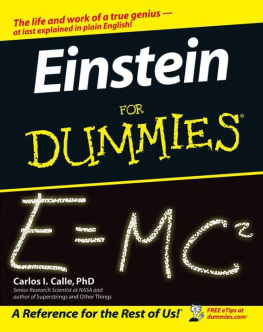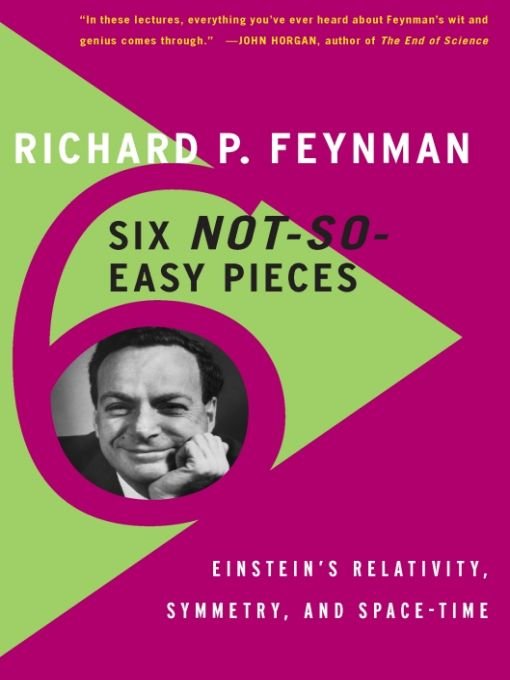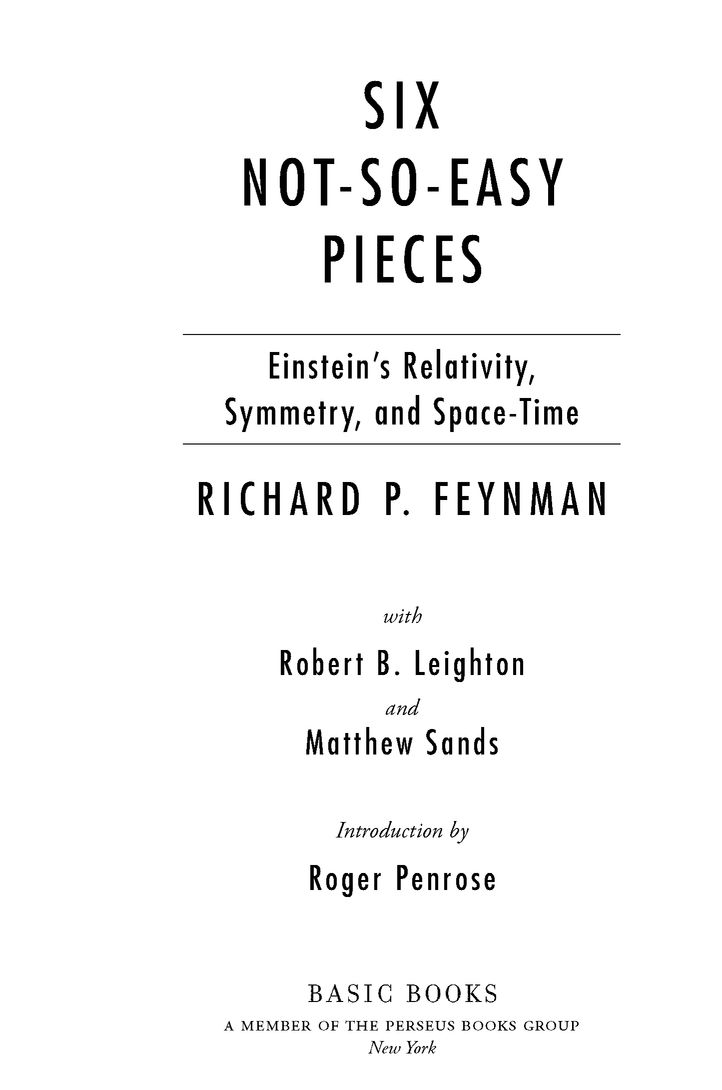Table of Contents
Also by Richard P. Feynman
The Character of Physical Law
Elementary Particles and the Laws of Physics:
The 1986 Dirac Memorial Lectures (with Steven Weinberg)
Feynman Lectures on Computation
(edited by Anthony J. G. Hey and Robin Allen)
Feynman Lectures on Gravitation (with Fernando B. Morinigo and
William G. Wagner; edited by Brian Hatfield)
The Feynman Lectures on Physics
(with Robert B. Leighton and Matthew Sands)
The Meaning of It All: Thoughts of a Citizen-Scientist
Photon-Hadron Interactions
Perfectly Reasonable Deviations from the Beaten Track:
The Letters of Richard P. Feynman
The Pleasure of Finding Things Out:
The Best Short Works of Richard P. Feynman
QED: The Strange Theory of Light and Matter
Quantum Mechanics and Path Integrals (with A. R. Hibbs)
Six Easy Pieces:
Essentials of Physics Explained by Its Most Brilliant Teacher
Statistical Mechanics: A Set of Lectures
Surely Youre Joking, Mr. Feynman!
Adventures of a Curious Character (with Ralph Leighton)
The Theory of Fundamental Processes
What Do You Care What Other People Think?
Further Adventures of a Curious Character
(with Ralph Leighton)
PUBLISHERS NOTE
The unqualified success and popularity of Six Easy Pieces sparked a clamor, from the general public, students, and professional scientists alike, for more Feynman in book and audio. So we went back to the original The Feynman Lectures on Physics and to the Archives at Caltech to see if there were more easy pieces. There were not. But there were many not-so-easy lectures that, although they contain some mathematics, are not too difficult for beginning science students; and for the student and the layperson, these six lectures are every bit as thrilling, as absorbing, and as much fun as the first six.
Another difference between these not-so-easy pieces and the first six is that the topics of the first six spanned several fields of physics, from mechanics to thermodynamics to atomic physics. These new six pieces you hold in your hand, however, are focused around a subject which has evoked many of the most revolutionary discoveries and amazing theories of modern physics, from black holes to worm holes, from atomic energy to time warps; we are talking, of course, about Relativity. But even the great Einstein himself, the father of Relativity, could not explain the wonders, workings, and fundamental concepts of his own theory as well as could that guy from Noo Yawk, Richard P. Feynman, as reading the chapters or listening to the CDs will prove to you.
We wish to thank Roger Penrose for his penetrating Introduction to this collection; Brian Hatfield and David Pines for their invaluable advice in the selection of the six lectures; and the California Institute of Technologys Physics Department and Institute Archives, in particular Judith Goodstein, for helping to make this book/CD project happen.
INTRODUCTION
To understand why Richard Feynman was such a great teacher, it is important to appreciate his remarkable stature as a scientist. He was indeed one of the outstanding figures of twentieth-century theoretical physics. His contributions to that subject are central to the whole development of the particular way in which quantum theory is used in current cutting-edge research and thus to our presentday pictures of the world. The Feynman path integrals, Feynman diagrams, and Feynman rules are among the very basic tools of the modern theoretical physicisttools that are necessary for the application of the rules of quantum theory to physical fields (e.g., the quantum theory of electrons, protons, and photons), and which form an essential part of the procedures whereby one makes these rules consistent with the requirements of Einsteins Special Relativity theory. Although none of these ideas is easy to appreciate, Feynmans particular approach always had a deep clarity about it, sweeping away unnecessary complications in what had gone before. There was a close link between his special ability to make progress in research and his particular qualities as a teacher. He had a unique talent that enabled him to cut through the complications that often obscure the essentials of a physical issue and to see clearly into the deep underlying physical principles.
Yet, in the popular conception of Feynman, he is known more for his antics and buffoonery, for his practical jokes, his irreverence towards authority, his bongo-drum performing, his relationships with women, both deep and shallow, his attendance at strip clubs, his attempts, late in life, to reach the obscure country of Tuva in central Asia, and many other schemes. Undoubtedly, he must have been extraordinarily clever, as his lightning quickness at calculation, his exploits involving safe-cracking, outwitting security services, deciphering ancient Mayan textsnot to mention his eventual Nobel Prizeclearly demonstrate. Yet none of this quite conveys the status that he unquestionably has amongst physicists and other scientists, as one of the deepest and most original thinkers of this century.
The distinguished physicist and writer Freeman Dyson, an early collaborator of Feynmans at a time when he was developing his most important ideas, wrote in a letter to his parents in England in the spring of 1948, when Dyson was a graduate student at Cornell University, Feynman is the young American professor, half genius and half buffoon, who keeps all physicists and their children amused with his effervescent vitality. He has, however, as I have recently learned, a great deal more to him than that.... Much later, in 1988, he would write: A truer description would have said that Feynman was all genius and all buffoon. The deep thinking and the joyful clowning were not separate parts of a split personality.... He was thinking and clowning simultaneously. Indeed, in his lectures, his wit was spontaneous, and often outrageous. Through it he held his audiences attention, but never in a way that would distract from the purpose of the lecture, which was the conveying of genuine and deep physical understanding. Through laughter, his audiences could relax and be at ease, rather than feel daunted by what might otherwise be somewhat intimidating mathematical expressions and physical concepts that are tantalizingly difficult to grasp. Yet, although he enjoyed being center stage and was undoubtedly a showman, this was not the purpose of his expositions. That purpose was to convey some basic understanding of underlying physical ideas and of the essential mathematical tools that are needed in order to express these ideas properly.
Whereas laughter played a key part of his success in holding an audiences attention, more important to the conveying of understanding was the immediacy of his approach. Indeed, he had an extraordinarily direct no-nonsense style. He scorned airy-fairy philosophizing where it had little physical content. Even his attitude to mathematics was somewhat similar. He had little use for pedantic mathematical niceties, but he had a distinctive mastery of the mathematics that he needed, and could present it in a powerfully transparent way. He was beholden to no one, and would never take on trust what others might maintain to be true without himself coming to an independent judgment. Accordingly, his approach was often strikingly original whether in his research or teaching. And when Feynmans way differed significantly from what had gone before, it would be a reasonably sure bet that Feynmans approach would be the more fruitful one to follow.


